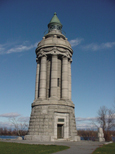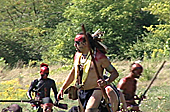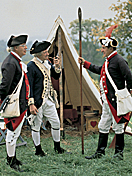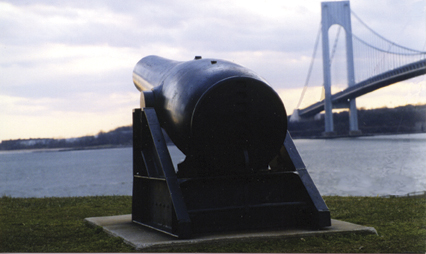
Champlain Memorial Lighthouse |
The New York State Independence Trail invites you to explore the historic waterways
of eastern New York. The strategic pulse of French and Indian and Revolutionary
War-era America, New York's waterways linked colonies, transported troops
and supplies, defined borders, and were pivotal in the successful British
campaign against the French, and in the American victory in The Revolution.

Ticonderoga (Re-enactment) |
Waterways were the natural superhighways of the late 18th century. From
the St. Lawrence River to the shores of Lake Champlain, to the clear blue
waters of Lake George, and the Mohawk River, to the mighty Hudson River,
battles raged and sacrifices were made. Relive our legacy and travel along
The New York Independence Waterways Trail.
Download
a PDF of the NEW Waterways brochure here!

Saratoga National Historic Park |
Experience
history, culture and natural splendor along The New York Independence
Waterways Trail. The sites named here can be viewed or accessed by car,
bicycle, foot, kayak, pleasure
craft or tour boat. Some are large museums and restored forts; others
are noted with simple signs and markers. All invite you to relive the
Birth of Our Great Nation.
Cruise the Lake Champlain Canal to Whitehall, where Benedict Arnold oversaw
the construction of America’s first gunships, earning Whitehall
the title, “Birthplace of the United States Navy.”
Visit the site of the Battle of Valcour Island where an American fleet
commanded by Arnold helped to foil the British plan to divide the colonies
in 1776. One of Arnold’s gunboats, scuttled during the night-time
retreat, was discovered in Lake Champlain in 1997.

Fort Hamilton |
Hike the trails of Mount Independence, the site of an American Revolutionary
War complex built to guard against a British attack from Canada. Dive
the waters of Lake George for a first-hand look at the sunken 1758 Radeau
Land Tortoise, the oldest intact warship in North America,
deliberately scuttled, then discovered by underwater archaeologists
in 1990.
Drop anchor and soak in the history of the islands of Lake George where
soldiers camped, prisoners were held and battles were waged.
Climb to the top of Rogers Rock where Major Robert Rogers was chased
by Indian and French soldiers.
Thrill in a living history tour of the reconstructed Fort William Henry
where 2,200 colonial defenders valiantly repelled attacks from French
troops until the siege by General Montcalm in 1757.
Picnic amidst the dramatic history of Lake George Battlefield Park,
the site of military engagements during both the French and Indian and
Revolutionary wars.
Not far from Cooper’s Cave, visit the Historic Feeder Canal Park
adjacent to the towpath that linked Glens Falls to the original Champlain
Canal.
A short trip from the Hudson River, tour the site of the famed Battles
of Saratoga — the turning point of the Revolution. The American
victory over General John Burgoyne proved to the world that the American
Continental Army was a force to be reckoned with and encouraged the
European community to support the American cause.
Stop by historic Fort Hardy Park to see the commemorative “Surrender
Tree” where Burgoyne admitted defeat and signed the Convention
of Saratoga in 1777.
Dock in Fort Edward and visit the site of Jane McCrea’s murder – an
event that enraged and rallied American militia. Within walking distance
are the Rogers Island Visitors Center and the Old Fort House Museum,
the only surviving building that headquartered both British and American
generals.
Retrace the torturous 300-mile trek of Henry Knox. This young American
officer valiantly transported 119,000 pounds of heavy artillery through
snow and ice along Lake Champlain and Lake George from Fort Ticonderoga
to Boston to help General George Washington fend off the British Navy.
Tour the visitor center and museum at Oneida County’s Oriskany
Battlefield, site of one of the bloodiest battles of the Revolution.
The fierce determination of American militia convinced the British to
abandon the siege of Fort Stanwix,protecting the Mohawk Valley. Take
a guided tour of General Nicholas Herkimer’s mansion. Herkimer
fearlessly led the American militia in this conflict. Experience the
Erie Canal Village outdoor living history museum nearby. The construction
of the Erie Canal made New York City the economic center of the New
World.
Visit the sentinels of the Hudson, Fort Clinton and Fort Montgomery.
These forts guarded the “Great Chain” that stretched from
Fort Montgomery to Anthony’s Nose to prevent British ships from
pressing forward up the Hudson.
Stand at the present-day site of Fort Hamilton, where in 1776 shots
were fired against the British, marking the first coastal defense of
the colonies.
Whether you are a history buff or a novice, there is plenty to learn
and enjoy along The New York Independence Waterways Trail. |


